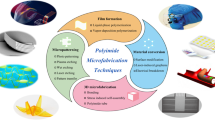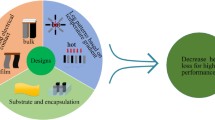Abstract
This paper reports a novel fabrication strategy for flexible electronics based on the parylene-MEMS (micro-electromechanical system) technique. A set of parylene-filled trenches is used to mechanically connect silicon-based functional units and realize a flexible 4×6 temperature controlling array as a preliminary demonstration. The trench-filling performance of the parylene deposition is carefully studied, and an optimized process is established to minimize the keyhole inside the parylene-filled trench. The effect of trench width on the flexibility and bendability of the prepared flexible electronics devices is analyzed by finite element modeling. Performances of the thermal/electrical isolation and the mechanical connection of the prepared parylene-filled trenches have been tested. The experimental results indicate that the highest thermal isolation efficiency is approximately 72.5% with the 10 paralleled, 7 μm wide and 50 μm deep parylene-filled trenches. The leakage current of the 10 paralleled, 5 μm wide and 100 μm deep parylene-filled trenches is less than 2 pA under a voltage of 100 V. Besides, these parylene-filled trenches acting as the flexible linkage of connected silicon-based functional units exhibit high connection performance without rupture when the loading pressure is under 200 kPa. Due to the powerful silicon microfabrication capability and excellent compatibility of the parylene-MEMS technique, the present flexible electronics strategy holds a promising potential for applications in various areas.
Similar content being viewed by others
References
Someya T, Sekitani T, Iba S, et al. A large-area, flexible pressure sensor matrix with organic field-effect transistors for artificial skin applications. Proc Natl Acad Sci USA, 2004, 101: 9966–9970
Someya T, Kato Y, Sekitani T, et al. Conformable, flexible, large-area networks of pressure and thermal sensors with organic transistor active matrixes. Proc Natl Acad Sci USA, 2005, 102: 12321–12325
Khodagholy D, Gelinas J N, Thesen T, et al. NeuroGrid: recording action potentials from the surface of the brain. Nat Neurosci, 2015, 18: 310–315
Russo A, Ahn B Y, Adams J J, et al. Pen-on-paper flexible electronics. Adv Mater, 2011, 23: 3426–3430
Kim H, Brueckner E, Song J Z, et al. From the cover: unusual strategies for using indium gallium nitride grown on silicon (111) for solid-state lighting. Proc Natl Acad Sci USA, 2011, 108: 10072–10077
Choi J, Xue Y G, Xia W, et al. Soft, skin-mounted microfluidic systems for measuring secretory fluidic pressures generated at the surface of the skin by eccrine sweat glands. Lab Chip, 2017, 17: 2572–2580
Webb R C, Bonifas A P, Behnaz A, et al. Ultrathin conformal devices for precise and continuous thermal characterization of human skin. Nat Mater, 2013, 12: 938–944
Ahn B Y, Duoss E B, Motala M J, et al. Omnidirectional printing of flexible, stretchable, and spanning silver microelectrodes. Science, 2009, 323: 1590–1593
Fan Z Y, Ho J C, Takahashi T, et al. Toward the development of printable nanowire electronics and sensors. Adv Mater, 2009, 21: 3730–3743
Kim D H, Lu N S, Ghaffari R, et al. Inorganic semiconductor nanomaterials for flexible and stretchable bio-integrated electronics. NPG Asia Mater, 2012, 4: 15
Wang Y, Zhu C X, Pfattner R, et al. A highly stretchable, transparent, and conductive polymer. Sci Adv, 2017, 3: 1602076
Xu J, Wang S H, Wang G J N, et al. Highly stretchable polymer semiconductor films through the nanoconfinement effect. Science, 2017, 355: 59–64
Kang S K, Hwang S W, Yu S, et al. Biodegradable thin metal foils and spin-on glass materials for transient electronics. Adv Funct Mater, 2015, 25: 1789–1797
Kim D H, Ahn J H, Choi W M, et al. Stretchable and foldable silicon integrated circuits. Science, 2008, 320: 507–511
Yu K J, Kuzum D, Hwang S W, et al. Bioresorbable silicon electronics for transient spatiotemporal mapping of electrical activity from the cerebral cortex. Nat Mater, 2016, 15: 782–791
Chung H J, Kim T, Kim H S, et al. Fabrication of releasable single-crystal silicon-metal oxide field-effect devices and their deterministic assembly on foreign substrates. Adv Funct Mater, 2011, 21: 3029–3036
Viventi J, Kim D H, Moss J D, et al. A conformal, bio-interfaced class of silicon electronics for mapping cardiac electrophysiology. Sci Transl Med, 2010, 2: 24ra22
Lei Y H, Wang W, Yu H Q, et al. A parylene-filled-trench technique for thermal isolation in silicon-based microdevices. J Micromech Microeng, 2009, 19: 035013
Ilic B, Czaplewski D, Zalalutdinov M, et al. Fabrication of flexible polymer tubes for micro and nanofluidic applications. J Vac Sci Technol B, 2002, 20: 2459–2465
Lei Y H, Luo Y C, Wang W, et al. Molecular effusion-boltzmann model for parylene C deposition in deep trench. In: Proceedings of IEEE International Conference on Nano/micro Engineered and Molecular Systems, Xiamen, 2010. 628–632
Lei Y H, Wang W, Yu H Q, et al. Deep trench refilling with parylene C for high-quality isolation in bulk micromachined devices. In: Proceedings of International Conference on Integration and Commercialization of MICRO and Nanosystems, HongKong, 2008. 601–604
Baldwin A, Meng E. A kirigami-based parylene C stretch sensor. In: Proceedings of IEEE International Conference on Micro Electro Mechanical Systems, Las Vegas, 2017. 227–230
Acknowledgements
This work was financially supported by National Natural Science Foundation of China (Grant No. U1613215), Beijing Natural Science Foundation (Grant No. L172005), and National Basic Research Program of China (973) (Grant No. 2015CB352100).
Author information
Authors and Affiliations
Corresponding author
Rights and permissions
About this article
Cite this article
Dong, X., Zhang, M., Lei, Y. et al. Parylene-MEMS technique-based flexible electronics. Sci. China Inf. Sci. 61, 060419 (2018). https://doi.org/10.1007/s11432-018-9430-2
Received:
Revised:
Accepted:
Published:
DOI: https://doi.org/10.1007/s11432-018-9430-2




